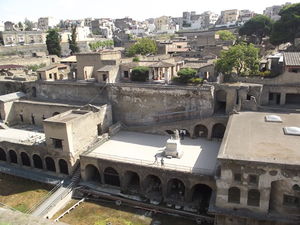Herculaneum: Difference between revisions
imported>Richard Nevell (Mention visitor numbers and popularity relative to Pompeii) |
imported>Richard Nevell No edit summary |
||
| Line 9: | Line 9: | ||
While Pompeii receives around 2.5 million visitors a year, Herculaneum attracts around a tenth of that number. The greater attention lavished on Pompeii is reflected in the published material relating to the two settlements. While Pompeii has been the subject of a host of works, both popular and academic, with constants additions, there is far less written about Herculaneum in English though it has still be the subject of much academic research.<ref>Wallace-Hadrill, Andrew (2011). ''Herculaneum: Past and Future''. London: Frances Lincoln Ltd. p. 7. ISBN 978-0-7112-3142-9.</ref> | While Pompeii receives around 2.5 million visitors a year, Herculaneum attracts around a tenth of that number. The greater attention lavished on Pompeii is reflected in the published material relating to the two settlements. While Pompeii has been the subject of a host of works, both popular and academic, with constants additions, there is far less written about Herculaneum in English though it has still be the subject of much academic research.<ref>Wallace-Hadrill, Andrew (2011). ''Herculaneum: Past and Future''. London: Frances Lincoln Ltd. p. 7. ISBN 978-0-7112-3142-9.</ref> | ||
==References== | |||
{{reflist}} | {{reflist}} | ||
Revision as of 09:33, 11 November 2012
Herculaneum was a Roman town in Campania, Italy, which was buried by the eruption of Mount Vesuvius in A.D. 79. Modern estimates of Herculaneum's population at the time of its destruction put the number of inhabitants at 4,000–5,000, compared to nearby Pompeii's population of 20,000.[1] It covered an area of just under 12 hectares, and the excavated areas show its streets were laid out on a grid pattern. Whereas Pompeii has been extensively excavated and a minority of the area within the city walls remains covered, historian Michael Grant writing in the 1970s commented that in comparison very little of Herculaneum had been thoroughly excavated: just four blocks.[2][3]
The first trace of Herculaneum to be discovered was the theatre. Between 1702 and 1715 Prince d'Elboeuf organised tunneling in the theatre, which until then had been exceptionally preserved. The statues decorating the theatre were stripped away and the structure damage. Organised excavation – as opposed to the looting of the early 18th century – began in 1738 and in 1775 the Herculaneum Academy was founded to support the investigation of the site. Grant noted that at the time of writing the theatre had still not been fully excavated.[4] Amongst the ruins of Herculaneum is a building which has become known as the 'Villa of the Papyri', the only surviving example of a library from Antiquity.[5] Since 1997, the town has been part the UNESCO's World Heritage Site 'Archaeological Areas of Pompei, Herculaneum and Torre Annunziata'.[6]
While Pompeii receives around 2.5 million visitors a year, Herculaneum attracts around a tenth of that number. The greater attention lavished on Pompeii is reflected in the published material relating to the two settlements. While Pompeii has been the subject of a host of works, both popular and academic, with constants additions, there is far less written about Herculaneum in English though it has still be the subject of much academic research.[7]
References
- ↑ Sigurdsson, Haraldur; Cashdollar, Stanford; and Sparkes, Stephen R. J. (1982). "The Eruption of Vesuvius in A. D. 79: Reconstruction from Historical and Volcanological Evidence", American Journal of Archaeology, vol. 86, no. 1, p. 39.
- ↑ Grant, Michael (1976). Cities of Vesuvius: Pompeii & Herculaneum. pp. 20, 59–60. London: Penguin Books.
- ↑ Ward-Perkins, John & Claridge, Amanda (1976). Pompeii AD79. Bristol: Imperial Tobacco Limited. p. 78. ISBN 0905692-00-4.
- ↑ Grant, Cities of Vesuvius: Pompeii & Herculaneum, pp. 20, 59–60, 215.
- ↑ Zarmakoupi, Mantha (2010). The Villa of the Papyri at Herculaneum archaeology, reception, and digital reconstruction. Berlin & New York: De Gruyter. p. vii. ISBN 9783110215434.
- ↑ Archaeological Areas of Pompei, Herculaneum and Torre Annunziata, UNESCO. Accessed 16 October 2012.
- ↑ Wallace-Hadrill, Andrew (2011). Herculaneum: Past and Future. London: Frances Lincoln Ltd. p. 7. ISBN 978-0-7112-3142-9.
